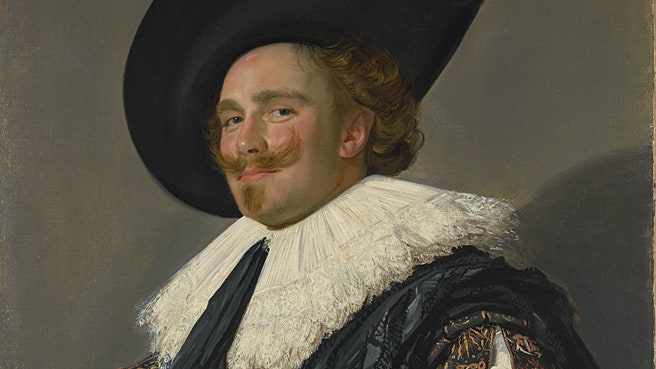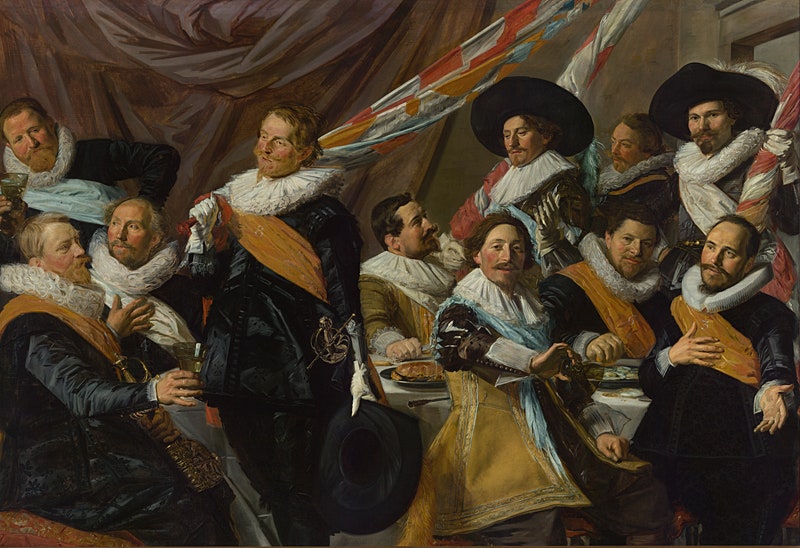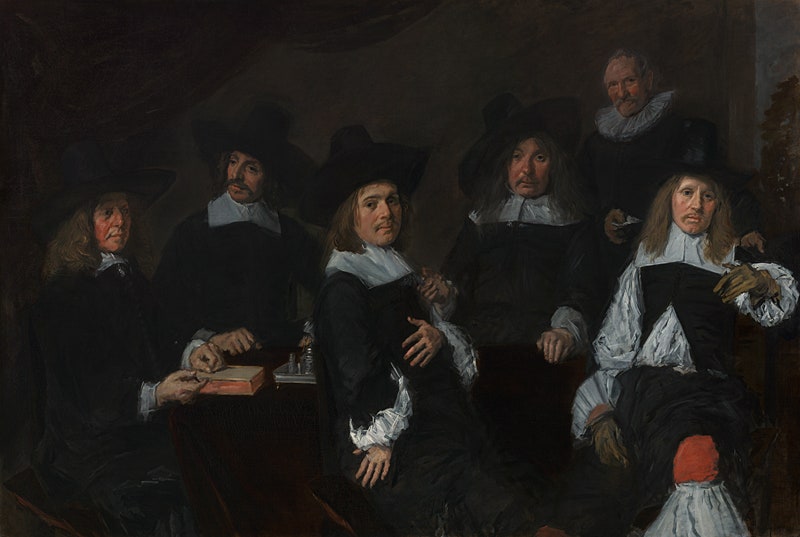
Save this storySave this storySave this storySave this story
The new retrospective of the Dutch painter Frans Hals at the National Gallery in London—the first major exhibition of his work since 1989—is a slightly nervous event for the most talented one-trick pony of the seventeenth century. Hals bet everything on portraiture. “Never did he paint Christs, annunciations to shepherds, angels or crucifixions and resurrections; never did he paint voluptuous and bestial naked women,” Vincent van Gogh wrote. “He painted portraits; nothing nothing nothing but that.” His two hundred or so paintings consist of a strict diet of burgomasters, brewers, pipe smokers, regents, street urchins, people holding various things in their hands (donkey’s jawbone, stretched pig’s bladder), and hundreds of Dutch heads plattered on flat linen collars and millstone ruffs. The question that hangs guillotine-like over the exhibition: Can we love him as much as Rembrandt and Vermeer?
Hals was not the second- or third-best Dutch painter of the seventeenth century; he was the best of the nineteenth. In the eighteen-sixties, the French art critic Théophile Thoré (who famously rescued Vermeer from oblivion) kicked off a revival of Hals, making him a favorite of art collectors and painters—Gustave Courbet and Édouard Manet, Mary Cassatt and James McNeill Whistler, Robert Henri and George Luks. (Luks reportedly said that the only two great painters in history were Hals and himself.) By 1900, the city of Haarlem had installed a statue of Hals in a public park. Even as he fell behind Rembrandt and Vermeer in the twentieth century, his paintings would retain a sheen of newness. According to the painter Lucian Freud, Hals was “fated always to look modern.”
His genius boils down to a contradiction: loose, unblended smears of paint that create the flesh-and-blood likeness of a human being. The late works of Titian, Velázquez, and Rembrandt would all head in this direction with their “rough” manner, but Hals achieved a kind of scary immediacy that seemed almost foreign to the medium—a photographer suddenly among painters. One of his satisfied customers, the scholar Theodorus Schrevelius, said that Hals’s portraits seemed “to breathe and to live.” His style was so distinct that he rarely even signed his paintings. There’s a sort of taunting element to them, with their passages of waxy smoothness that suddenly combust into vibrating little sparks. Your eye can never really settle on the picture; it’s constantly being stirred and needled by the brushwork.
What we know about Hals with certainty—and it’s not much—is that he was born in Antwerp between 1582 and 1584, and spent most of his eighty-plus years in Haarlem, about eleven miles from Amsterdam, swatting away various kinds of debt. (A nursemaid, tavern owner, tradesman, and baker all took him to court.) He married twice and fathered at least fourteen children, five of whom he buried, and two of whom he sent to workhouses—a daughter for being promiscuous, a son for being mentally disabled. He died, penniless, in the summer of 1666.
You wouldn’t expect this man to be a famous painter of warm cheer and tavern jollity, whose trademark expressions were smiling and laughter. Nor would you expect him to be paying off his debt with furniture when the Dutch economy was booming. Just before Hals was born, the Dutch Republic had broken away from Spain and declared its independence. A low-lying, semiliquid territory (what one Englishman described as “the buttock of the world”) was being dried out by windmills and converted into the center of a global trade empire. Artists like Hals and Rembrandt didn’t have a Philip IV of Spain or a Cardinal Barberini in Rome—there was no longer a royal family, and Catholicism was only begrudgingly tolerated, so court and church commissions were minimal—but they could secure private commissions from aldermen, textile magnates, the remnants of noble families, or preachers, doctors, and an ascendant middle class. The Dutch were a God-chosen people, and they were hungry for images of themselves.

“Banquet of the Officers of the St George Civic Guard,” circa 1627.Art work by Frans Hals / © Frans Hall Museum
The National Gallery exhibition includes fifty paintings and is a more streamlined version of the 1989 retrospective. When we first meet Hals, he’s around thirty years old and a meester schilder (master painter) in the local art guild. There are no juvenilia or early false starts; no one even knows what he was doing for the first part of his life, though one source tells us that he was “lusty” as a youth. His early portrait of Pieter Cornelisz van der Mersch (1616), a satirist from Leiden, shows Hals already at full tilt, bearing a style that’s not too far-flung from where he would land fifty years later. Van der Mersch has a herring pinched in his right hand and a bundle of straw in the other. The gesture is a riff on a Dutch proverb that means something like “to take the piss out of someone.” As will become his custom, Hals paints the portrait like he’s short on time. The linen cuff on van der Mersch’s right hand is done in four touches, max. Even when you’re standing ten feet back from the canvas, you can peel off individual brushstrokes with your eyes. They’re just floating there, like little spears of light.
The two showstoppers of the exhibition appear in the second room, grouped under the elusive theme of “Portraiture into Art.” The first is “The Laughing Cavalier” (1624), Hals’s most famous painting, though it’s not a particularly Halsian one. Sure, the sitter has a Renaissance elbow—the arms-akimbo pose Hals used to give his portraits more depth and swagger—but the smooth density of the man’s face is much more van Dyck-ish. The painting is on loan from the nearby Wallace Collection, where it typically hangs on sumptuous red wallpaper and gets a lot of admiring attention. Here, it almost slumps into the gallery of faces.
The real coup of the exhibition is Hals’s masterpiece “Banquet of the Officers of the St George Civic Guard” (circa 1627), which has left Haarlem for the first time since it was painted nearly four hundred years ago. Between 1616 and 1664, Hals was commissioned to paint nine major group portraits—six of militiamen and three of regents. To see what he did for group portraiture as a genre, compare his 1627 painting with Cornelis van Haarlem’s portrait of the same guard, from 1599. In the van Haarlem, the whole scene is overcrowded and stiff. Every officer’s mouth is zipped shut, and all of the faces look vaguely milky and homogenous. With Hals, you’re turning up to a live banquet. The lieutenant Frederik Coning has a lemon in his fist and is mid-squeeze over a tray of plump oysters. (It’s moments like these that Hals is famous for.) The star of the painting is the guard’s captain, Michiel de Wael, who wears a yellow jerkin with an icy-blue sash in the foreground. His loose-jawed, watery facial expression, the critic John Berger once noted, had never been captured before in paint: “We watch Captain de Wael as the sober always watch a man getting tipsy—coldly and very aware of being an outsider. It is like watching a departure for a journey we haven’t the means to make.”
In the sixteen-twenties and thirties, Hals came into his own as a so-called genre painter, moving beyond strict portraiture. In a part of the exhibition devoted to his “Invented Characters,” we meet the staples of Halsania: the merry drinkers, the boys playing lutes, the fisher children, the deranged woman with an owl on her shoulder. These were cheaper paintings that could be sold via auction or lottery and hang in family homes, butcher shops, or brothels. Hals didn’t have to satisfy the vanity of a newly married couple or the scion of a wealthy brewer clan. His brushwork could fully unwind, and his worst (or best) painterly habits found their match in comic characters like “Pekelharing” (1625), whose face appears to be sliding off itself like a warm cheese. Is he drunk, or are we?
By the sixteen-forties, portraits in the Dutch Republic had taken a Flemish turn: slender faces and fingers, a “smooth” manner of painting, a fetish for shiny fabric. Hals dutifully paints the fashions of the moment but keeps doing it in his own freewheeling way. In his portrait of the perfectly arrogant Jasper Schade, a Dutch politician, the brushwork on the face is tightly thatched and then, as if Hals has suddenly swallowed a caffeine pill, a whole taffeta sleeve bursts into a lightning field. The paintings gradually get looser, darker. (Van Gogh once claimed that Hals had twenty-seven different blacks.) When we reach his last piece in the exhibition, “Regents of the Old Men’s Alms House” (1664), Hals has gone full Manet. He’s in his eighties and appears to be freed from whatever demands his sitters might have. One of the almshouse regents looks like a melted puppet. Another could be easily mistaken for a corpse.

“Regents of the Old Men’s Alms House,” 1664.Art work by Frans Hals / © Frans Hals Museum
Until Thoré revived Hals in the nineteenth century, he was known less for his painting than for his drinking. All of the relevant tidbits—that he couldn’t keep out of the taverns, that he once kissed van Dyck, that his apprentices tucked him into bed at night—come from a largely discredited 1718 account by Arnold Houbraken. In the exhibition catalogue, the art historian Jaap van der Veen makes the enticing rear-guard choice to revive part of Houbraken’s account. Who’s to say that Hals did not “fill himself to the gills each evening”? He was not especially productive, he likely shirked administrative duties in his local art guild, and his finances were chronically mismanaged. Maybe it was a thirst for Rhenish wine or ale. Maybe Hals was just lazy.
This exhibition follows a blockbuster Vermeer show at the Rijksmuseum, which sold over half a million tickets, and a landmark Rembrandt retrospective in 2019, which turned into a “year of Rembrandt” celebration. A run-of-the-mill Hals exhibition feels vaguely doomed by comparison, as though we’re resigned to giving him the bronze medal of the Dutch Golden Age. Vermeer’s paintings have inspired an opera, a rockabilly song, and a feature film with Scarlett Johansson (“Girl with a Pearl Earring”); Rembrandt has a town in Iowa named after him, as well as a toothpaste. The best argument you could make for Hals is that he excelled at making more with less. How much feeling could be squeezed into a single brushstroke? How much range into a single genre (portraiture)? How much personality into a single color (black)? A single pose (the Renaissance elbow)? A single expression (laughter)?
Hals was a painter of fundamentally modest means with a deep intuition for his medium. If he were alive today, one imagines that he’d feel rather confused about the fuss over his work. His one surviving self-portrait is from a 1639 painting of the St George Civic Guard, still in Haarlem, where you can see Hals in the upper left-hand corner, peeping out between two sets of shoulders. He looks almost surprised to have made it into his own picture. After all, wasn’t he only a portraitist? It was a profession, not a calling. His job was to disappear into the paint. ♦
Sourse: newyorker.com






